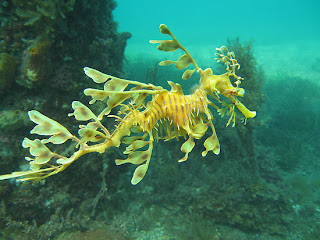The Leafy Seadragon uses the fins along the side of its head to allow it to steer and turn. However, its outer skin is fairly rigid, limiting mobility.
Much like the seahorse, the Leafy Seadragon's name is derived from its resemblance to another creature (in this case, the mythical dragon). While not large, they are slightly larger than most seahorses, growing to about 20–24 cm (8–10 in). They feed on plankton and small crustaceans.
Individual Leafy Seadragons have been observed remaining in one location for extended periods of time (up to 68 hours) but will sometimes move for lengthy periods. Tracking of one individual indicated it moved at up to 150 metres (490 feet) per hour. The Leafy Seadragon is related to the pipefish and belongs to the family Syngnathidae, along with the seahorse. It differs from the seahorse in appearance, form of locomotion, and its inability to coil or grasp things with its tail. A related species is the Weedy Seadragon, which is multi-coloured and grows weed-like fins but is smaller than the Leafy Seadragon.
The Leafy Seadragon is related to the pipefish and belongs to the family Syngnathidae, along with the seahorse. It differs from the seahorse in appearance, form of locomotion, and its inability to coil or grasp things with its tail. A related species is the Weedy Seadragon, which is multi-coloured and grows weed-like fins but is smaller than the Leafy Seadragon.Cares For The Eggs.
As with seahorses, the male Leafy Seadragon cares for the eggs. The female produces up to 250 bright pink eggs, then deposits them on to the male's tail via a long tube. The eggs then attach themselves to a brood patch, which supplies them with oxygen. It takes a total of nine weeks for the eggs to begin to hatch, depending on water conditions.
The eggs turn a ripe purple or orange over this period, after which the male pumps its tail until the infants emerge, a process which takes place over 24–48 hours. The male aids in the babies hatching by shaking his tail, and rubbing it against seaweed and rocks. Once born, the infant seadragon is completely independent, eating small zooplankton until large enough to hunt mysids. Only about 5% of the eggs survive. Leafy Seadragons take about 28 months to reach sexual maturity.









0 comments:
Post a Comment